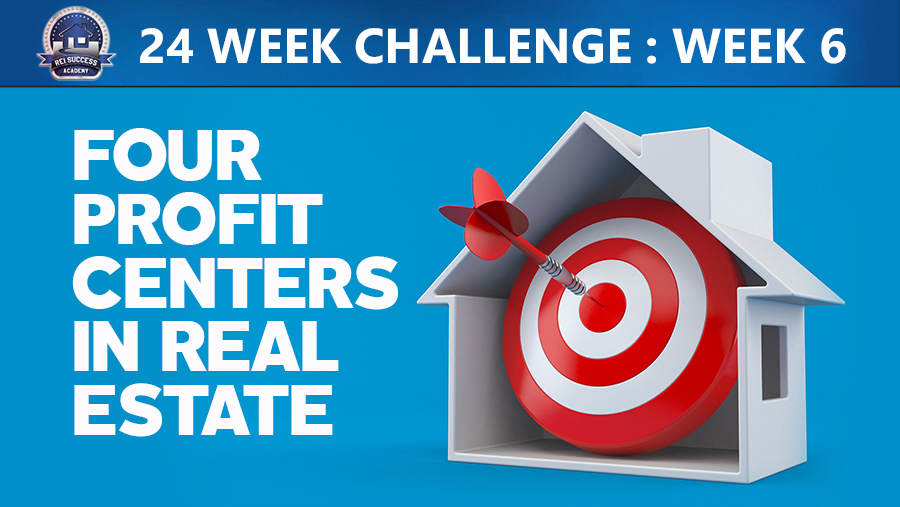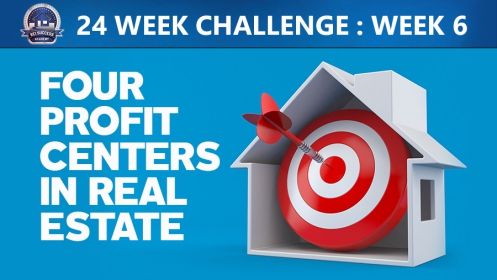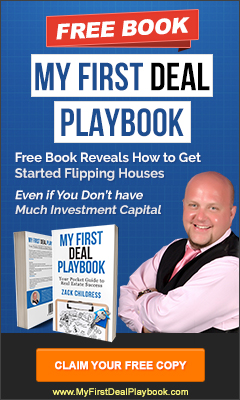
We’re tackling a big question with the 24-week challenge, and now we’ve hit week 6. The question is: How do real estate investors build real wealth and freedom without access to millions of dollars in capital? Zack Childress is leading us through the steps to the answer.
Our topic today is the Four Profit Centers in Real Estate. The 4 profit centers can be represented as a set of 4 stairs. Each step builds upon the next—and each step adds a little more complexity and requires more resources.
You need to determine which profit center suits you best and you’ve got to make sure you are in line with that profit center. If you have no money and bad credit, you need to focus on Profit Center 1, which is wholesaling.
See, wholesalers don’t need financing or proof of funds. You are not going to close on the house. Rather, you negotiate a contract with the seller and sell the contract to a buyer for cash. You are out of the end deal based on language in the assignment agreement. This is a great strategy for starting an investing career.
Profit Center 2 is creative deal structuring, and we also go into detail about Profit Centers 3 and 4. The journey from Centers 1 to 4 can be quick or it could take a few years… it all depends on your knowledge, resources and support.
If you don’t feel confident that you can execute properly, you need to keep learning, build your resources and use the guidance of an experienced mentor.
Lots of great info in this episode.
Watch and learn:
Listen and enjoy:
What’s inside:
- How the 4 Profit Centers build upon themselves
- Which Profit Centers don’t require financing
- How lease options can relieve owners facing foreclosure
- What three categories of resources you need to succeed
Mentioned in this episode:
- Reach Zack by phone: 707.247.4248
- Follow Zack on Facebook: REI Success Academy Facebook
- Zack’s Book: My First Deal Playbook
- REI Success Academy Web Class
Transcription:
Download episode transcript in PDF format here…
So the big question is this, how do aspiring real estate investors like us escape from the rat race and build real wealth and freedom without access to millions of dollars in investment capital and start to live the life that we know we deserve? This is the question and this podcast will give you the answer. My name is Zack Childress and welcome to Real Estate Investing Talk Show.
You’re on week 6, which is the Four Profit Centers. So let’s go through Profit Center One for you real quick. Profit Center One is really if you, if you were to draw out a set of stairs. Okay, let me just see if I can help you visualize this. If you had a set of stairs. And then you said this was Profit Center One. This was Profit Center 2, Profit Center 3, and this was Profit Center 4. So if you, if you laid it out like that right – that’s how the steps happen in your real estate business, okay? That’s how you start to grow. That’s how you start to climb the scale as a real estate investor.
Now people say to me all the time and was like, how do you know which profit center to be in? Well, this goes back to if you’ve ever gotten my book. I have a book called, My First Deal Playbook. It’s on Amazon. You can search My First Deal Playbook and you’ll l find it. And inside that book I talk a lot about these four profit centers and how most investors give up because they try the wrong profit center and they don’t really do the profit center that’s really for them.
And so that’s why I say to you guys, you got to really think about where you are and where you want to be and you’ve got to make sure that you’re in line with the profit centers. For instance, if you’re the type of person that has no money and you have horrible credit and you can’t even get an asset lender to work with you, then you need to be focused on profit center one because profit center one is the easiest way to get in. It’s where you’re selling contracts, you’re wholesaling, and this might help a lot of the confusion with some of you that think that you know when you’re dealing with agents – why they ask for a lot of information and you might assume that that’s what the homeowners want and that’s not the homeowners don’t do.
I’ve been doing this for 16 plus years. I can tell you right out the gate, homeowners have no clue with what most agents are asking you for Profit Center 1. Just to get clear with you has everything to do with you working directly with you working directly with for sale by owners, okay? Profit Center 1 is everything that encompasses wholesaling. Now, wholesaling has nothing to do with buying houses. Wholesaling has nothing to do with going to a bank to get a loan. Wholesaling has nothing to do with working with an agent, so let’s get clear on that. Wholesaling has nothing to do with banks. Wholesaling has nothing to do with asset lenders. Wholesaling has nothing to do with closing on a property. Wholesaling has nothing to do with any of that. Wholesaling doesn’t even have anything to do with agents if you don’t want it to.
Wholesaling has everything to do with working with for sale by owners. Wholesaling has everything to do with just going directly to a for sale by owner and negotiating a deal with the for sale by owner. That’s wholesaling, okay? That’s wholesaling. Wholesaling also has nothing to do with the financing. So when I get a rhetorical nonsense question or statement that says the seller wants me to put 20 percent down, then I I know very clearly that somebody just lying to me because the sellers can’t control that. Sellers can’t tell you to do that. Sellers have nothing to do with you getting financing and the other side of the equation is, is you’re not getting the financing. You’re the whole seller. You’re putting the contract with the seller and you’re taking that contract and you’re selling it to a buyer, a cash buyer.
As a traditional wholesaler, you literally have no bank needed. You have no proof needed of funds. You have no need to get a down payment. You have no need to close or open up. You don’t have any of those needs. You simply are getting a contract with a seller and you’re selling your rights to that contract to an end buyer. That is wholesaling in a nutshell. That is tier one, investing, wholesaling. So many people get confused with wholesaling because they think that that means they go to an agent, they get a property at a discount, they buy it, and then they turn around and sell it at a higher price. That’s not wholesaling, that’s just flipping houses. That’s what that is.
Wholesaling has everything to do with getting a contract, selling your rights to that contract to an end buyer, and then that buyer needs to make sure he gets his proof of funds together. He goes to the bank, he gets his 20 percent down, 15 percent down, whatever his bank requires him to do, and that buyer then does what – closes escrow with the seller because you’ve removed yourself from the transaction by using an assignment agreement. We about this this weekend in LA and all the things that are in that, and there’s certain clauses you gotta make sure you put it in there. That gives you the rights to assign it, like buyer reserves, the right to assign a buyer reserves the right to take title and name or entity of choice. So that’s my point like and now here.
Now, not to confuse you guys, but tier one encompasses a lot of different wholesaling strategies. For example, wholesaling – you have traditional wholesaling, which is what we all know, find properties at a discount, find a cash buyer and wholesale the contract, right?
Remember what this guy says, “wholesalers, you’re not selling a property, you don’t own the property. You don’t even have the rights to own the property.” You need to make sure you understand this, is that you are selling the contract, okay? The contract. That’s what’s important to know. No lawyer can dictate how you put money down. That’s the beauty of that. This is why you’re here learning so that you become a smarter investor. No lawyer can dictate how much you put down. No salary can dictate how much you put down. And here’s the beauty. If you’re the whole seller, do you even have to worry about how much gets put down? No. Because you’re getting a loan? No. You’re selling the contract. The only person that can dictate how much the buyer puts down is the bank based on their fair lending rights, their programs, their risk analysis.
They’re the only ones that can do that, okay? They’re the only ones that can do that. So inside tier one you have traditional wholesaling, you have coho selling, which is where you’re working with other wholesalers. So contracts you have whole selling the option, which is when you put a property under contract with seller financing available and there’s no real cash flow to be made off of it. Then that means that at that point, you can then wholesale the option to the tenant buyer and move on. Lots of success in that if wholesaling to a finance buyer, this is where you use the demand of funds letter. You have wholesaling commercial and you have wholesaling REOs. There’s really six forms of true wholesaling strategies that can be done inside of tier one. You don’t need to do them all.
Do I suggest you learn them? Absolutely. That’s how you become a master in wholesaler, but you start with one at a time, okay? You start with one at a time.That’s tier one, wholesaling. That’s one profit center into your business.
So, let’s move on to Profit Center 2 which is all about creative structure. So creative structure is all about how you control properties and make money of them, right? Like, how can I control a property and still make money on that property? Well, that’s through creative financing. And creative financing comes in all types of shapes and forms from wraparound mortgages to contract for deeds to land installment contracts. There’s just so many of them. One of my favorites and one of the easiest ones for anybody to apply is the lease option.
The lease option is my favorite tier two strategy and it’s easy to get across because it’s a long-term lease with the option to buy and that is something that a lot of sellers need help with. And here’s why. Think of it this way. We’re talking about tier two and lease options and why they’re so important. The beauty of the lease option is this – is that there is a big need for a lease option type deal out there. And that is where we talk to a seller and we get them to leave the financing in place that’s already on the property. Which means if they have a loan on that property, we leave that loan in place and we do what’s called a long term lease with the option to buy that property. And that’s a great strategy, especially for people that are in pre-foreclosure or expired listings. Sometimes in the rental ads you can find people who are renting because they couldn’t sell it and they have a payment pain.
So I’m here to encourage you that if you want to build cash flow in your business, then what you need to do is, you need to take your business into more of a lease option strategy. If you can’t go to the banks and get financing, that’s targeting the right person. So what it is to you, you have a long-term lease. You’re putting a lease on a property so that lease could be 2, 3, 4, 5, 7, or 8 years. It just depends on what you negotiate with the seller. And in return, if you fulfill your lease, you have the option to buy that property. Or you could even say, I want a four year lease, but I want the option to buy this property at any time during this four year lease. Now people will say, well, why would a seller do that? Well, the seller will do that because they can’t keep up with their payments – number one. Number two, they might be facing foreclosure and they can’t sell it because there’s no equity in it. So the other side of it is people say, well, why would you buy a house that has no equity in it? Well, because the long term of it, right? I’m looking for properties that can produce cash flow.
Let me give you an example. Somebody has a property that’s $200,000 worth and they owe $195,000 on it. Well, the likelihood is there’s no investor’s ever gonna want that property. And number two, it makes it hard for them to sell that property because why? Because they can’t sell it with an agent because there’s not enough equity in it, right? There’s not enough equity spread in it for them to even pay the commissions and they don’t even have the money. So the challenge is, is they have to face foreclosure or not pre-foreclosure or they might lose the property, right? So they become vacant. They walk away from it. So when you come in and say, look, don’t go to foreclosure, don’t ruin your credit, I’ll take it over. I’ll take over the debt that’s on the property. I’ll make your payments for you. I just want a four- year lease with the option to buy it. And so if I fulfill my leas, then I’ll buy it. Now why is it beneficial to them? Because you’re taking over all their headaches.
This is not a rental property. So you’re not saying, look, I’m going to rent it from you. You’re saying I’m going to lease it with the option to buy it, which means I’m not calling you to come fix a broken window. I’m not calling you to come fix a clogged toilet. I’m not calling you to come over and you know, do things to the property because I’m going into ownership. I’m going to own it one day, so therefore I’m going to take on all that risk and so that’s the beauty of that type of lease with the option to buy. Now even on top of that, it gives you the advantage to sublease it, which is why it’s called a sandwich lease option. That’s a beautiful thing because that’s when we take over their payment.
Let’s say their payment is $600 a month, but I can rent it for $900 a month. Well then that’s why I want that deal because I want to make the $600 a month payment to them, but I’m going to rent it for $900 so I make $300 a month off what’s called the spread – the difference and what I’m renting it out for and what I’m paying the homeowner. That’s why we call it the perfect tenant program. The perfect tenants are people who have down payments. These are people who have good jobs. They just don’t have very good credit and they can’t go to the bank and get a loan. That’s what you have to think about and that’s why the program works. There’s is a whole process to it, so that’s a tier two. It’s the next step, right? We start with wholesaling, we create cashflow, but we create cash capital, I should say.
Without buying anything, without getting a loan, both tier one and tier two don’t require you to go to the bank or even get a loan. They don’t require it, and that’s the beauty of those two programs. Then you move into tier three, which is fix and flip. It’s all about rehabbing. That’s the beauty, now you move into the next level. Now when you go after rehabs as a rehabber or are you buying from wholesalers? Yes, you are. You’re now buying those contracts that you are putting together as a wholesaler, so you’re buying contracts from wholesalers then you now go to the bank and the bank dictates or tells you how much you’ve got to put down to get a loan to buy that property or an asset based lender or a hard money lender. They’re going to tell you how much you have to put down and that’s going be where you understand how much capital you need to do.
Tier three, where do we create that capital for their down payments through tier one? We can create it through tier two also because when a tenant buyer moves into a property, they give you what’s called an option fee. It’s $2,500. Could be $6,000 that they pay you up front for the option to buy the property, but that leads you into Tier three, alright?
So the fourth one and the final one of the four profit centers is where you all want to be, right? Tier one, tier two, tier three, which is fix and flip. Rehabbing, where you go to the banks, you go to asset lenders, you’re actually acquiring funds to buy a property, to fix it up, hire a contractor and make money, okay?
The next one is buy and holds. That’s where you want to be – at a buy and hold is when you’re getting into cash flow. It’s where you’re buying long-term assets and look that step one to step for some of you might be able to pull that off in three weeks. Some of you might pull that off in six months. Some of you you might not be able to get to Tier 4 for two or three years, but don’t get discouraged with it, okay? Just know that everybody gets to that level differently and it has everything to do with their knowledge. How much knowledge do they have about the business and can they execute like they’re supposed to, their resources, what do they have available to them to help them grow and obviously their support. It’s all about knowledge, resource and support. That’s what it boils down to, you know? Do you have the knowledge it takes to grow this business? Do you have it? If you do, then yes, you can move into starting the business.
If you don’t have the knowledge and you don’t even understand how loans work, like how you have to go to a bank or how contracts work. If you don’t know that, then you need to keep studying, right? You need to get the right support and you need to keep studying with a coach, mentor something of that nature. If you’ve got the knowledge that you need to help you move forward and you have resources, then it makes it easier for you to move into tier three, tier four, which means you’ll get there faster.
If you don’t have those resources, then with the right knowledge, you can create those resources with the right support, right? And the support is just to help you get the knowledge you need, create the resources that you want so that you don’t make mistakes moving forward, and that’s really the three core fundamentals to understand. Do you have the knowledge and can you get it and where can you get it? Do you have the resources and if you don’t, what do we need to do to create resources and do you have the support to help you get to where you want to be?
So you’ve been listening to the Real Estate Investing Talk Show. Zack Childress, and I’m on a mission to create 10,000 real estate bosses over the next year. Will you be one of them? Head over to my website, Reisuccessacademy.com/web class, and register for my free web class will you’ll discover how to escape from the nine to five grind and become your own boss in real estate. See you there.









